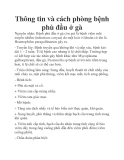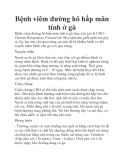
Mycoplasma gallisepticum
-
Đề tài Bổ sung những tư liệu về bệnh do Mycoplasma ở gà trong điều kiện chăn nuôi hiện nay ở Việt Nam; xác định được các chủng Mycoplasma phổ biến gây bệnh trên đàn gà chăn nuôi cụ thể ở Việt Nam và vai trò của chúng trong hội chứng bệnh đường hô hấp của gà, nghiên cứu được quy trình chế tạo kháng nguyên, kháng huyết thanh cho chẩn đoán bệnh. Mời các bạn tham khảo.
 178p
178p  thangnamvoiva22
thangnamvoiva22
 03-10-2016
03-10-2016
 126
126
 26
26
 Download
Download
-
Nguyên nhân: Bệnh phù đầu ở gà còn gọi là bệnh viêm mũi truyền nhiễm (infectious coryza) do một loài vi khuẩn có tên là Heamophilus paragallinarum gây ra. - Truyền lây: Bệnh truyền qua không khí và tiếp xúc, bệnh kéo dài 1 – 2 tuần. Tỉ lệ bệnh cao nhưng tỉ lệ chết thấp. Trường hợp có kết hợp các tác nhân gây bệnh khác như Mycoplasma gallisepticum, đậu gà, Pasteurella sp bệnh sẽ trở nên trầm trọng hơn, tỉ lệ chết sẽ có thể cao hơn. - Triệu chứng lâm sàng: Sưng đầu, huyết thanh từ chất...
 3p
3p  nkt_bibo40
nkt_bibo40
 17-01-2012
17-01-2012
 138
138
 12
12
 Download
Download
-
Bệnh viêm đường hô hấp mãn tính ở gà (hay còn gọi là CRD – Chronic Respiratory Disease) do Mycoplasma gallisepticum gây ra, lây lan chủ yếu qua trứng: gà mái đẻ bị nhiễm bệnh có thể truyền mầm bệnh cho gà con qua trứng. Nguyên nhân Ngoài ra do gà khoẻ tiếp xúc trực tiếp với gà nhiễm bệnh và mang mầm bệnh. Bệnh có thể gây thiệt hại kinh tế nghiêm trọng do giảm khả năng tăng trưởng và năng suất trứng. Thời gian nung bệnh thường từ 6 – 10 ngày. Mức độ bệnh thay đổi khác...
 3p
3p  nkt_bibo39
nkt_bibo39
 17-01-2012
17-01-2012
 143
143
 14
14
 Download
Download
CHỦ ĐỀ BẠN MUỐN TÌM
















